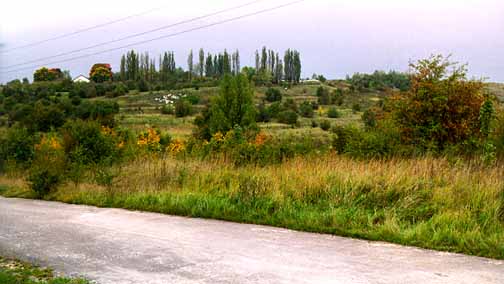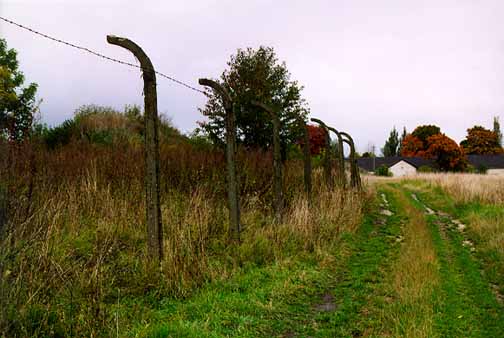Plaszow Concentration Camp
 Site of the former
camp at the village of Plaszow
Site of the former
camp at the village of Plaszow
The photograph above, taken in October
1998, shows the spot where the barracks of the Plaszow concentration
camp once stood. The Camp Commandant, Amon Goeth, lived in a
house that is out of camera range in this picture; it is located
to the right and behind a hill so that it cannot be seen from
this spot. The camp was surrounded by houses on three sides and
on the fourth side was a major road.
To reach the site of the former Plaszow
camp, 10 kilometers from the city center of Krakow, we drove
up a hill on a rutted one-lane dirt road, thinly covered with
small white granite rocks. The road reminded me of a road up
to a cemetery that I had visited in my youth, and I soon learned
that this was also the site of a Jewish cemetery before the Nazis
made it into a labor camp. The granite quarries near this location
were at that time owned by a Jew, but the Nazis confiscated the
property, without compensation, for their labor camp. There was
a Jewish mortuary chapel near the cemetery, which the Nazis converted
into a stable. This was not the first time that a Jewish place
of worship was used by the Nazis as a stable.
The location of the Plaszow camp on the
site of two Jewish cemeteries afforded building materials for
the Nazis in the construction of the camp. Although crushed granite
from the quarry was readily available, the Nazis desecrated Jewish
graves by ripping out the tombstones, then using slabs of the
broken grave stones to pave the camp roads, like stepping stones
in a garden, as pictured in the movie Schindler's List.
The construction of the Plaszow camp
began in June 1942. A guidebook which I purchased at the Eagle
Pharmacy museum in Podgorze, not far from the Plaszow camp, states:
"According to the Heydrich plan the Plaszow camp and its
sub camps were meant to constitute a stage in the concentration
of the Jews deported to the East. The camp was built on the area
of two cemeteries at Jerozolimska and Abrahama street. The location
of the camp -- near the Plaszow railroad station -- made the
access to communication tracks relatively easy." The "Heydrich
plan" was a reference to the conference which SS officer
Reinhard Heydrich led on January 20, 1942 at Wannsee, a suburb
of Berlin. This is where plans were made for the "Final
Solution of the Jewish Question."
By July 1944, the Russians had advanced
into Poland, as the Germans retreated. Majdanek was the first
Nazi camp to be liberated by the Russians on July 23, 1944; it
was now necessary for the German occupation government to begin
the liquidation of the Plaszow camp. The bodies of 8,000 prisoners,
who had died in the camp, were dug up and burned, according to
the author of the novel, Schindler's List. The barracks were
dismantled and sent to other camps along with the camp records.
The Plaszow prisoners were transferred to other camps, the last
transport leaving on Jan. 12, 1945 just three days before the
Red Army liberated Krakow.
According to my tour guide, the Germans
fought a fierce battle with the Russians in the city of Krakow.
It was so cold that the Vistula river was frozen over. Dead German
soldiers littered the streets of Krakow when the battle was finished.
According to the tour guide, their bodies were buried by the
citizens of Krakow.
Schindler's factory in Krakow, which
was a sub-camp of the Plaszow camp, had to be liquidated along
with the concentration camp as the Germans retreated. To save
his Jewish workers from being sent to other camps, Schindler
bribed Nazi officials to let him set up a new factory sub-camp
in Brinnlitz near his home town of Zwittau in Moravia, a province
of the former country of Czechoslovakia. At that time, Moravia
was a protectorate of Germany.
In the movie Schindler's List, Oskar
Schindler was allowed to select 1,100 Jews for his new factory,
after bribing the Nazis with diamonds, ham and liquor. The male
prisoners of Plaszow were sent to Gross-Rosen, a concentration
camp that was also built near a quarry; it had 103 sub-camps
and Schindler's factory became the 104th. Gross-Rosen is now
in Poland, but at that time, it was in the Greater German Reich.
The female prisoners at Plaszow were sent to Auschwitz II or
Birkenau, including Schindler's Jews, because they had to wait
until Schindler's new sub-camp was built.
By 1944, the whole Plaszow camp had become
a hotbed of corruption with black market trading in stolen goods
by the inmates and by the Commandant, Amon Goeth. The prisoners
were selling the bread, provided by the Nazis for the camp, to
Polish civilians outside the camp and the price had finally reached
diamonds as currency, according to the novel Schindler's List.
When Oskar Schindler was granted permission
to draw up a list of 1,100 slave workers for his new Brinnlitz
factory in what is now the Czech Republic, a Jewish prisoner
named Marcel Goldberg was put in charge of the names, according
to the novel. Goldberg asked for bribes from those who wanted
on the list and the price was paid in "stolen treasures,"
mostly diamonds. There was a jewelry factory at Plaszow where
the prisoners had an an opportunity to steal diamonds. At the
end of the list, Goldberg put his own name. There were 800 men
and 300 women on Schindler's List; some had also gotten on the
list by making threats to Goldberg, according to the novel. Oskar
Schindler didn't know all the names of his 1200 factory workers,
and had never spoken to most of them.
At the age of 29, Mini Reinhardt became
Schindler's secretary in October 1944; she had previously been
working in a labor camp near Krakow. In an interview with the
Israeli daily newspaper Ha'aretz in December 2007, Reinhardt
said "I only typed the list. I did what I was told."
According to her interview with a Ha'aretz
reporter, Reinhardt was born in Vienna in 1915, but at the age
of 21 married a Jew from Krakow and moved to the Polish city.
The couple had a son in June 1939, but three months later the
war broke out. Son Sascha was smuggled with his grandmother to
Hungary, where he survived the war, but her husband was shot
while trying to escape from the Krakow ghetto and she was sent
to a labor camp.
Reinhardt told the Ha'aretz reporter
that it was a "gamble" when she decided to join Schindler
at his new factory near his home town.
The following quote is from the Ha'aretz
article:
The gamble almost proved fatal, when
the Nazis sent the train with the 1,100 workers to the Auschwitz
death camp, where she spent 10 days that she described as "straight
from the hell of Dante."
But Schindler went out of his way
to persuade the camp authorities to release his workers to his
new ammunition factory, threatening to accuse them with Nazi
authorities in Berlin of "sabotaging the war effort."
Reinhardt rejected speculation by
some that his motivations were opportunistic, being driven initially
by money while his eventual rescue operation was an attempt to
better himself as it became clear the Germans were about to lose
the war.
"He wasn't an angel," she
told Ha'aretz, pointing out he was a member of the SS and at
nights had drinks with the highest ranks of the Nazi force.
But, she added, "I saw a man
who constantly risked his life for what he did. He was a Mensch.
He must have had a heart of gold."
The photo below shows what is left of
the barbed wire fence which formerly surrounded the Plaszow camp.
The tour guide told me that there were houses built right up
to this fence when the camp was in operation. The camp was built
right next to the village of Plaszow which was on the Ostbahn
railroad line running through Krakow.
 Remnant of the barbed
wire fence around the Plaszow camp
Remnant of the barbed
wire fence around the Plaszow camp
|